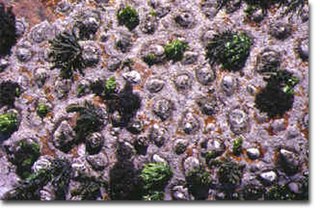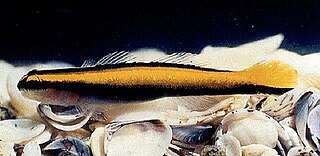
A reef is a shoal of rock, coral or similar material, lying beneath the surface of water. Many reefs result from natural, abiotic processes—deposition of sand, wave erosion planing down rock outcrops, etc.—but the best known reefs are the coral reefs of tropical waters developed through biotic processes dominated by corals and coralline algae.

Coralline algae are red algae in the order Corallinales. They are characterized by a thallus that is hard because of calcareous deposits contained within the cell walls. The colors of these algae are most typically pink, or some other shade of red, but some species can be purple, yellow, blue, white, or gray-green. Coralline algae play an important role in the ecology of coral reefs. Sea urchins, parrot fish, and limpets and chitons feed on coralline algae. In the temperate Mediterranean Sea, coralline algae are the main builders of a typical algal reef, the Coralligène ("coralligenous"). Many are typically encrusting and rock-like, found in marine waters all over the world. Only one species lives in freshwater. Unattached specimens may form relatively smooth compact balls to warty or fruticose thalli.

Crustose is a habit of some types of algae and lichens in which the organism grows tightly appressed to a substrate, forming a biological layer. Crustose adheres very closely to the substrates at all points. Crustose is found on rocks and tree bark. Some species of marine algae of the Rhodophyta, in particular members of the order Corallinales, family Corallinaceae, subfamily Melobesioideae with cell walls containing calcium carbonate grow to great depths in the intertidal zone, forming crusts on various substrates. The substrate can be rocks throughout the intertidal zone, or, as in the case of the Corallinales, reef-building corals, and other living organisms including plants, such as mangroves and animals such as shelled molluscs. The coralline red algae are major members of coral reef communities, cementing the corals together with their crusts. Among the brown algae, the order Ralfsiales comprises two families of crustose algae.

Rhodoliths are colorful, unattached calcareous nodules, composed of crustose, benthic marine red algae that resemble coral. Rhodolith beds create biogenic habitat for diverse benthic communities. The rhodolithic growth habit has been attained by a number of unrelated coralline red algae, organisms that deposit calcium carbonate within their cell walls to form hard structures or nodules that resemble beds of coral.

Parazoanthus axinellae, commonly known as the yellow cluster anemone, is a zoanthid coral found on the southern Atlantic coasts of Europe and in the Mediterranean Sea. Zoanthids differ from true sea anemones, in having a different internal anatomy and in forming true colonies in which the individual animals (polyps) are connected by a common tissue, called the coenenchyme.

Siderastrea siderea, commonly known as massive starlet coral or round starlet coral, is a stony coral in the family Siderastreidae. It is found in shallow parts of the western Atlantic Ocean as solid boulder-shaped or domed structures.

Cliona viridis, commonly called the green boring sponge, is a species of demosponge in the family Clionaidae. Its form varies according to the nature of the surface on which it grows. In limestone and other calcareous substrates it excavates channels and chambers while on other types of rock it encrusts the surface or forms massive structures. It is native to the eastern Atlantic, the Mediterranean Sea and the Indo-Pacific Ocean.

Spongites yendoi is a species of crustose red seaweed with a hard, calcareous skeleton in the family Corallinaceae. It is found on the lower shore as part of a diverse community in the southeastern Atlantic Ocean and the Indo-Pacific Ocean.

Alcyonium acaule or Mediterranean sea-finger is a species of soft coral in the family Alcyoniidae. It is found at moderate depths on shaded rocks in the Mediterranean Sea and adjoining parts of the Atlantic Ocean.

Alcyonium coralloides, commonly known as false coral, is a colonial species of soft coral in the family Alcyoniidae. It is native to the northeastern Atlantic Ocean and the Mediterranean Sea. In the former location it generally grows as sheets or small lobes but in the latter it is parasitic and overgrows sea fans.

Caryophyllia smithii, the Devonshire cup coral, is a species of solitary coral in the family Caryophylliidae. It is native to the northeastern Atlantic Ocean, the North Sea and the Mediterranean Sea. There are shallow and deep-water forms which are structurally different. It forms part of a biodiverse community of rock encrusting organisms and is often parasitised by a barnacle.

Clavularia crassa is a species of colonial soft coral in the family Clavulariidae. It is found in the eastern Atlantic Ocean and the Mediterranean Sea. It was first described in 1848 by the French zoologist Henri Milne-Edwards from a specimen collected off the coast of Algeria.

Maasella is a genus of soft coral in the family Paralcyoniidae. It is monotypic, with only a single species, Maasella edwardsi. Usually of greenish brown or golden brown color, each polyp has eight pinnate tentacles. This soft coral is found in the Mediterranean Sea and the Atlantic Ocean, at depths of between 2 and 50 metres.

Elacatinus figaro, the barber goby or yellow line goby, is a colourful species of marine goby, family Gobiidae, from the southwestern Atlantic, where it is endemic to the coastal waters of Brazil.
Aspidosiphon elegans is a species of unsegmented benthic marine worm in the phylum Sipuncula, the peanut worms. It is a bioeroding species and burrows into limestone rocks, stones and corals. It occurs in the western Indo-Pacific region, the Red Sea, and the tropical western Atlantic Ocean, and is invasive in the eastern Mediterranean Sea.
Sporolithon is a genus of red coralline algae in the family Sporolithaceae, in the order Corallinales.
Zanardinia is a monotypic genus of seaweed in the brown algae. The only species, Zanardinia typus, commonly known as penny weed, is native to the northeastern Atlantic Ocean and the Mediterranean Sea.
Corticium candelabrum is a species of sponge in the order Homosclerophorida. It is native to the eastern Atlantic Ocean and the Mediterranean Sea where it inhabits the shallow sublittoral zone. The type locality is the Adriatic Sea.

Lithophyllum orbiculatum is a species of thalloid coralline algae, which are a red algae whose cell walls contain calcareous deposits.

Hildenbrandia rubra is a marine species of thalloid red alga. It forms thin reddish crusts on rocks and pebbles in the intertidal zone and the shallow subtidal zone. It is a common species with a cosmopolitan distribution, and is able to tolerate a wide range of conditions.















